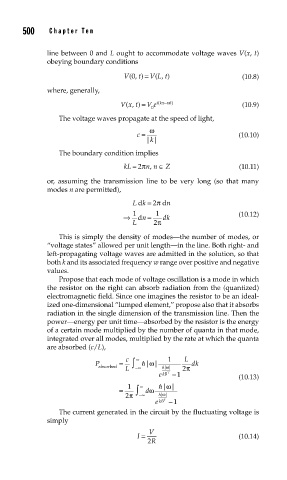Page 547 - Sensors and Control Systems in Manufacturing
P. 547
500
Cha p te r
T e n
line between 0 and L ought to accommodate voltage waves V(x, t)
obeying boundary conditions
,
(
0
V(, t) = V L t) (10.8)
where, generally,
(
(,
Vx t) = V e ikx−ω t) (10.9)
0
The voltage waves propagate at the speed of light,
ω
c = (10.10)
||
k
The boundary condition implies
,
kL = 2π n n ∈ Z (10.11)
or, assuming the transmission line to be very long (so that many
modes n are permitted),
Lk = 2π d n
d
⇒ 1 d n = 1 dk (10.12)
L 2π
This is simply the density of modes—the number of modes, or
“voltage states” allowed per unit length—in the line. Both right- and
left-propagating voltage waves are admitted in the solution, so that
both k and its associated frequency w range over positive and negative
values.
Propose that each mode of voltage oscillation is a mode in which
the resistor on the right can absorb radiation from the (quantized)
electromagnetic field. Since one imagines the resistor to be an ideal-
ized one-dimensional “lumped element,” propose also that it absorbs
radiation in the single dimension of the transmission line. Then the
power—energy per unit time—absorbed by the resistor is the energy
of a certain mode multiplied by the number of quanta in that mode,
integrated over all modes, multiplied by the rate at which the quanta
are absorbed (c/L),
c
ω
P = ∫ ∞ h|| 1 L dk
ω
absorbed −∞ h|| π
L 2
T
e kB −1
(10.13)
ω
= 1 ∫ ∞ dω h||
ω
2 π −∞ h h||
T
e kB −1
The current generated in the circuit by the fluctuating voltage is
simply
I = V (10.14)
2 R

